 April 23, 2015 John E. Ross, KD8IDJ, Editor
| ||||||||
Amateur Radio Heads into WRC-15 "With Every Possibility of Success" The recently ended second World Radiocommunication Conference 2015 (WRC-15) Conference Preparatory Meeting (CPM15-2) left Amateur Radio "with every possibility of success" heading into WRC-15 this fall, said ARRL Chief Technology Officer Brennan Price, N4QX. Price was on the US delegation at CPM15-2, which wrapped up on April 2. The 2-week-long meeting addressed a variety of spectrum-related matters, including several dealing with Amateur Radio. Its Report to WRC-15 focuses on technical, operational, and regulatory matters that ITU member-states will consider in developing their proposals to WRC-15. More than 1250 participants from 105 ITU member-states attended.
In addition to Price, those representing Amateur Radio at CPM15-2 included International Amateur Radio Union (IARU) President Tim Ellam, VE6SH/G4HUA; Bryan Rawlings, VE3QN (Canada); Ulrich Mueller, DK4VW (Germany); Ken Yamamoto, JA1CJP (Japan); Hans Blondeel Timmerman, PB2T (The Netherlands), and IARU Vice President Ole Garpestad, LA2RR (Norway). Delegates to CPM15-2 okayed text for WRC-15 agenda item 1.4, dealing with a secondary Amateur Radio allocation at 5 MHz. "The methods proposed in the text, as expected, are all over the map -- ranging from no change to an expansive allocation of 5275-5450 kHz, with explicit suggestions of 15 kHz and 100 kHz in between, and a few methods with details to be filled in later," Price explained. "In short, there is a wide divergence of opinion, and no certainty as to the outcome." Text for other Amateur Radio-related agenda items "appropriately reflects our concerns," Price said. "Text for agenda item 1.1 correctly notes that no compatibility studies between Amateur Radio and mobile
broadband applications have been conducted for the bands under consideration in which there is an Amateur Radio allocation." He said a method for agenda item 1.6, proposing to authorize Fixed-Satellite Service operation in the 10-10.5 GHz band, was removed from the final text, while a method was added to agenda item 1.12 at the request of the US to provide appropriate protections to the Amateur Satellite Service at 10 GHz, "to supplement the high degree of compatibility that proposed Earth Exploration Satellite Service operation has demonstrated in the band," he added. WRC-15 will get under way on November 2 in Geneva, and will conclude on November 27. World Radiocommunication Conferences are mandated to review and revise the Radio Regulations, the international treaty governing the use of RF spectrum and satellite orbit resources. François Rancy, Director of ITU's Radiocommunication Bureau, said the outcome of CPM15-2 "represents a major step in the preparations for WRC-15." FCC Proposes to Make Past Amateur Radio Address Information Private The FCC is seeking comments on a Notice of Proposed Rule Making (NPRM) in WT Docket 15-81 that would restrict routine public inspection of an Amateur Radio licensee's address history. The proposal, released March 31, calls for removing from public view in the Universal Licensing System (ULS) Amateur Radio licensee address information not associated with a current license or pending application.
The proposed change would not affect public access to a licensee's current address information, which would remain available. "We believe that publicly available licensee address information facilitates the Amateur Radio community's self-regulation and maintains the distinction between the Amateur Service and other radio services," the FCC said in the NPRM. The Wireless Bureau also solicited public input on whether it should extend the same approach to individual licensees in any other radio services. The FCC said that it has, in recent years, received occasional requests from amateur licensees to remove their address information from public access in the ULS. "These requests are not granted, because Section 0.453(d)(4) requires that the information be available for public inspection in ULS," the Commission explained. The FCC noted in the NPRM that the ULS includes not only current authorizations and pending applications, but expired, canceled, or terminated licenses; archived versions of active licenses, and applications that have not been processed. "Information available on ULS includes a licensee's name and address, and technical information about the authorization requested or granted," the NPRM explained. The FCC pointed out that an Amateur Radio licensee is not required to provide a home address, just a valid mailing address. "Those who are concerned about their residential address appearing in ULS may use, among other alternatives, a post office box, a business address, the address of another property the licensee owns, or the address of a friend or relative as their mailing address," the NPRM suggested.
Comments are due in the proceeding by June 16, with reply comments due on July 16. Amateur Radio Volunteers Activate Emergency Nets Following Chile Volcano Eruption Southern Chile's Calbuco volcano erupted this week for the first time in more than 40 years, forcing the evacuation of an area of some 12 miles around the volcano. Approximately 5000 residents have been relocated, and ash has been reported from as far away as Argentina.
"Nature strikes our Chilean brothers one more time," said International Amateur Radio Union Region 2 news editor Joaquín Solana, XE1R. IARU Region 2 reports that emergency nets are in operation on 7050 kHz, 14,250 kHz (alternate), and 3,738 kHz (alternate), and requests that other users keep those frequencies clear for emergency traffic. According to Chile's National Mining and Geology Service, the column of ash measures nearly 7 miles. The agency said volcanic activity was diminishing but that the state of emergency remains for the affected region. NPR quoted correspondent Lourdes Garcia-Navarro, who reported that local officials are saying people are very frightened. "The immediate concern is the volcano's eruption could trigger snow melts and cause flooding," she said. According to NPR, the volcanic activity "seems to have caught Chile's geologists by surprise." No injuries have been reported so far. ARRL "Ham Aid" HF Gear Arrives in Micronesia in Wake of Tropical Cyclone An ARRL "Ham Aid" kit of HF gear has arrived in Federated States of Micronesia (FSM) as part of a relief effort in the wake of Tropical Cyclone Maysak. The Ham Aid equipment accompanied a shipment of radio gear, tools, and supplies that John Bush, KH6DLK/V63JB, took from Hawaii to FSM last week. Tropical Cyclone Maysak ravaged many of the nation's islands in late March and early April, wreaking major damage and causing some deaths. ARRL Hawaii Section Manager Bob Schneider, AH6J, said he spoke with Bush via a phone patch established through the station of Richard Darling, AH7G, and Barbara Darling, NH7FY.
Schneider said Bush stopped first on Yap Island, spending a couple days talking to government and civil authorities concerning recovery planning and the school situation. Bush told Schneider that Yap Island suffered little damage. Bush reported that the airport on Falalop Island was damaged but operational. "He reports most buildings -- including his own -- were destroyed," Schneider said. "The operations building at the airport, high school, and a couple others had damage but were stronger than most buildings. The high school lost its roof and the computer lab was flooded, along with all the computers." Bush told Schneider that there is a massive amount to debris all around. Bush was able to borrow two 60 Ah batteries on Falalop, and replacements are in one of the cargo shipments coming from Guam. He also has two small, sealed batteries that he was able to transport on his flight. Suitcase solar panels that Bush transported from Hawaii have worked very well, Schneider said, adding that Bush suggested that the ARRL obtain a couple of these units as power backup in isolated areas, as part of the Ham Aid package.
Bush told Schneider that the HF equipment was working well and that he prefers to operate during daylight, since electrical power has not yet been restored on the island. "The power company is replacing poles, and it may take some time to get commercial power back," Schneider said. Schneider said Bush had not yet made his way to any of the other islands in Ulithi Atoll, such as Federai. "Second-hand reports from those are grim," he said, and responders have been in short supply. With a population of about 103,000, FSM is comprised of four states over 600 islands -- about 1800 miles from end to end. Typhoon Maysak struck Ulithi Atoll with 160 MPH winds, with gusts to 195 MPH -- a Category 5 storm. A major storm surge of unknown height also hit, and infrastructure on most islands, including schools, homes, and the power and telecommunication systems, suffered major damage or were destroyed altogether. Schneider has requested that the Amateur Radio community listen for relief traffic on HF, but not to interrupt if vital communications are in progress. Ham Aid kits containing both HF and VHF/UHF gear had been shipped to Hawaii last fall, as the massive Puna volcanic lava flow threatened some communities on the Big Island of Hawaii. It includes both HF and VHF gear. Only the HF gear was sent to FSM. Read more. Spratlys DX0P DXpedition Participant Evacuated for Medical Emergency One of the participants in the just-ended DX0P DXpedition to the disputed Spratly Islands was airlifted from Pag Asa Island after suffering a medical emergency. Chito Pastor, WW6CP, became ill just as the DXpedition was starting to wrap up on April 20.
Almazan said that he and four other team members were able to return to the Philippines on another flight. The remaining team members will remain on Pag Asa until a Philippines Navy Nomad aircraft picks them up on April 24. "From what I heard, they were all busy snorkeling all day," said Almazan, who is now at his Angeles City home in the Philippines. He said he plans to fly stateside next month for Dayton Hamvention®. According to Amateur Radio DX.com, an Adventist Medical Aviators Services aircraft that picked up Pastor landed safely in Puerto Princesa without incident. Members of the Mabuhay DX Group went to Pag Asa Island earlier this month and operated for about 5 days, logging some 5000 contacts. All of the DXpedition participants have roots in or reside in the Philippines.
A Philippines TV news account posted on the InterAksyon.com website on April 22 reported that Pastor developed kidney problems from drinking from the highly saline water supply on Pag Asa after the DXpedition's drinking water supply ran short. According to the InterAksyon report, a Chinese naval vessel had "harassed a Philippine Air Force patrol flight in the Spratlys" by firing an illumination round on April 21. Almazan told ARRL that the Philippines military later backed away from that account, but the incident caused the postponement of future flights to Pag Asa Island, including the Philippine Navy flight that was to evacuate Pastor. The aircraft set to pick up Pastor later developed mechanical problems, causing further delay, and the Adventist flight was subsequently cleared to make the medical mission on April 23. The InterAksyon report noted that China "has embarked on an aggressive reclamation and construction spree" in the Spratlys, which are claimed in whole or in part by China, the Philippines, Vietnam, and other countries. The Philippines National Telecommunications Commission issued the DX0P license. Spratly Island is number 75 on the ClubLog DXCC Most Wanted List. Almazan headed a nine-member team to Pag Asa Island. "I can write a novel about this DXpedition!" Almazan told ARRL. Participants May Apply Anytime for Centennial Points Challenge, W1AW WAS Awards The window to apply for ARRL Centennial Points Challenge and W1AW Worked All States awards has been open for a month now, and the initial rush of applications has been processed. Participants' Centennial Points Challenge logs must already have been submitted via Logbook of The World (LoTW) -- the cut-off date was January 22 -- but the League will continue to accept award applications indefinitely. With little to no backlog in the queue, it's anticipated that processing will be prompt.
Most applicants will find the process simple and largely automated. The form will auto-populate, if ARRL has the applicant's information on file. The form may be edited to update name and address information only. The system will select the awards for which the applicant qualifies. Certificates will be printed daily. Plaques will be shipped directly from the supplier. Certificates will be available for the Centennial Points Challenge Award, while W1AW WAS Award participants can order a certificate, a plaque, or both -- ordered separately on the website. Certificates are $16, and plaques are $60. Qualifying for the Top Level Centennial Points Challenge Award requires 15,000 points. The Third Level Award requires 7500 points, while the Second and First Level awards require 3000 and 1000 points, respectively. Point totals will be printed on certificates. ARRL 600 Meter Experiment Coordinator Recommends Renewing Experimental License ARRL 600 Meter Experiment Coordinator Fritz Raab, W1FR, said the mission of the multi-station experimental operation "has actually been accomplished," but since the US still has no medium-frequency (MF) Amateur Service allocation, he believes the Experimental license ought to be renewed. Raab commented in his most recent quarterly status report on the experiment, prepared with John Langridge, KB5NJD, and Warren Ziegler, K2ORS. The interim report said the WD2XSH operations have demonstrated that the Amateur Radio community is interested in MF operation.
The FCC has yet to act on the ARRL's 2012 Petition for Rulemaking asking it to create a domestic Amateur Radio allocation at 472-479 kHz, known variously as 600 meters and 630 meters. Delegates to the 2012 World Radiocommunication Conference (WRC-12), approved a 7-kilohertz-wide secondary Amateur Radio allocation at 472-479 kHz, with a power limit of 5 W EIRP (or 1 W EIRP, depending on location). Radio amateurs in Canada and in several other countries already have allocations there. Canadian 630 meter operators held a cross-band event on February 14, listening on 160 and 80 meters for US stations. The WD2XSH license is set to expire in August, Raab noted in his report. "This is therefore a good time to look at what WD2XSH has accomplished and to consider whether it should be renewed," he said. "Following the WRC-12 decision to create an amateur 630-meter band, most of us expected the FCC to approve access for US amateurs," Raab's report said. "Had this happened, there would not be further need for the WD2XSH license. Over 2 years have passed since the ARRL petitioned the FCC to consider this band, and the FCC does not appear to be in any hurry to do so."
According to the report, which covered WD2XSH operations through February 28, the experiment also has demonstrated reliable regional ground-wave communication. "This will make possible regional beyond-line-of-sight emergency communications that is available at all times of day and is not subject to whims of the ionosphere," the report added. The report also pointed out that in 179,000 hours of operation, "there has not been one complaint of harmful interference from either other radio services or utility power-line communications." The FCC cited concerns about possible interference to utility power-line carrier (PLC) systems in deciding not to adopt its own 2002 proposal for an LF allocation in the vicinity of 137 kHz. Raab said the ARRL "should have a continued presence in our quest for a 630 meter amateur band" and recommended renewing the license. Read more. Australian Ham's "PicoSpace" Balloon Circumnavigates the Globe A foil, party-type balloon carrying a ham radio payload has circumnavigated the globe. Launched on April 6 by Australian radio amateur Andy Nguyen, VK3YT, of Kensington, Victoria, Australia, the balloon, designated PS-41, completed its round-the-world journey on April 16. It remained aloft until April 22, when Nguyen reported that it had gone down near South America. Along the way, it has been tracked by a network of Amateur Radio operators. Nguyen has been trying since early last year to have one of his launches go full circle.
"PS-41 crossed the starting longitude of 144.903 at 11:20 AM AEST (0120 UTC) this morning, completing the first PicoSpace around-the-world trip," Nguyen posted on April 16. "Thanks to everyone for assistance with tracking and providing encouragement for the project; the trip would not have been possible without you." In January, Nguyen's PS-30 balloon went down in suspected poor weather off the east coast of Africa near Madagascar. The solar-powered, helium-filled PS-41 balloon carried an HF payload, sending WSPR spots and JT9 telemetry on 30 and 20 meters from a 25 mW transmitter. The high-attitude PS-41 took a path over Tasmania, then south of New Zealand, the southern tip of South America, directly over the South Georgia and South Sandwich islands, well south of Africa, and back across to Australia. Nguyen's companion PS-42 balloon made its way to the South Pacific between New Zealand and South America, but it went down at about the same time PS-41 completed its round trip. The balloons were extensively tracked via JT9 by a network in Australia, New Zealand, South America, South Africa, and Ireland. WSPR spots were received from all over the world. -- Thanks to Jim Linton, VK3PC IEEE 2015 International Microwave Symposium to Include Amateur Radio Presence If Dayton Hamvention® doesn't satisfy your need for wireless exuberance, the so-called "World Series of RF" will convene in Phoenix, Arizona, the following week -- May 17-22. The annual IEEE International Microwave Symposium (IMS) attracts thousands of professional and academic RF specialists every year -- many of them radio amateurs. And ARRL will have a seat at the table, so to speak.
More than 500 exhibitors will be at IMS 2015, along with materials and services vendors, top of the line equipment manufacturers, and exotic new startups looking to publicize their technology. Don't let the word "microwave" intimidate you. There is something of interest starting below the AM Standard Broadcast band all the way to the millimeter wavelengths.
Part of the IMS fun is a significant academic presence. Hundreds of students and educators participate in workshops, design competitions, and the presentation of papers and posters. Along the way, they exchange ideas and get acquainted with other programs from universities and colleges around the world. This year's 16 design competitions range from wideband baluns to SDRs to high-efficiency power amplifiers and high-sensitivity receivers. Post-secondary interest in communications and wireless technology has never been higher. If you're an RF professional and plan to attend IMS 2015, the ARRL invites your help to explain and promote Amateur Radio to show visitors. Contact the ARRL's IMS booth manager, Ward Silver, N0AX, and find out how you can share your stories of how ham radio has helped spark your interest and sustain the arc of your RF career! -- Thanks to Ward Silver, N0AX CQ DQs Two Dozen CQ World Wide DX Contest SSB Participants The CQ World Wide Contest Committee has disqualified 2 dozen entrants in the 2014 CQ World Wide DX Contest (SSB) last October. Another six received warnings. The committee said that it has warned contesters to play fairly and to obey the rules. The vast majority of the disqualifications were for "unclaimed assistance."
Disqualified entrants are given 5 days to respond. "We do this to allow everyone the opportunity to present an explanation of what appears in the log," the Committee said. CQ received 8283 logs containing more than 5.2 million contacts for the CQ WW SSB. Contest participants represented 223 different countries. Log checking for the 2014 CQ WW DX Contest CW is now complete and have been sent to CQ Magazine. Official results will appear in the May 2015 issue of CQ. ARRL Teachers Institute Sessions Still Accepting Applications The ARRL Education & Technology Program is still accepting applications for all four sessions of the ARRL Teachers Institute this summer. Apply now! The deadline is May 1.
"If you are a past participant of the Teachers Institute we hope that you have found many ways to use the ideas, training and resources you received and are interested in spreading the word to other teachers," said ARRL Education Services Manager Debra Johnson, K1DMJ. "Consider signing up for the advanced TI-2, 'Remote Sensing and Data Gathering.'" The March QST article, "The ARRL Teachers Institute on Wireless Technology," includes the schedule and course descriptions. More information is on the ARRL website. Amateur Radio Special Events to Mark International Marconi Day April 25 is International Marconi Day (IMD), organized by the Cornish Radio Amateur Club in Cornwall, UK. IMD recognizes the anniversary of the birth of wireless pioneer Guglielmo Marconi, born on April 25, 1874. Participating stations are expected to be on the air during the Among stations planning to be on the air is VP8VPC in the Falkland Islands. The VPC suffix recalls the call sign of the Marconi spark transmitters in Stanley. The 150 kW transmitter built in 1915 fed seven 305-foot masts and operated on 60-70 kHz. It was the most remote and most powerful station in the Royal Navy's First World War network of stations. After the war, VPC handled commercial message traffic to South America. IMD certificate information and additional details are on the IMD website. NCDXF Announces Major DXpedition Grants The Northern California DX Foundation (NCDXF) has announced a $50,000 grant to the VK0EK Heard Island DXpedition, planned for The NCDXF also has donated $20,000 to the just-announced KH5 Palmyra Atoll DXpedition, planned for January 2016. Palmyra is number 10 on the ClubLog DXCC Most Wanted List. Within the last year, NCDXF has given $175,000 in grants to DX operations in Iran, Andaman, Navassa, Eritrea, Tromelin, South Sandwich, South Georgia, Chesterfield, and Heard. -- Thanks to Glenn Johnson, W0GJ, NCDXF Vice President The K7RA Solar Update Tad Cook, K7RA, Seattle, reports: Solar activity perked up this week, with average daily sunspot numbers rising from 65.6 in the previous 7 days to 120.9 in the April 16-22 period. Average daily solar flux increased from 132.5 to 150.4 over the forecast period. The day with the greatest geomagnetic activity was April 16, when the mid-latitude A index hit 28, the planetary A index was 43, and the high-latitude college A index in Alaska was 57. These are high numbers!
Predicted planetary A index is 15, 8, 12, and 5 on April 23-26, 8 on April 27-30, 12 on May 1, 8 on May 2, 5 on May 3-5, 8 on May 6-8, 5 on May 9-11, then 8, 15, 20, 12, 8, and 12 on May 12-17, and 5 on May 18-19. You can download and examine my archive of these forecasts, updated daily, for flux values and Ap index (click the "Download this File" button; files are Excel spreadsheets). This weekly "Solar Update" in The ARRL Letter is a preview of the "Propagation Bulletin" issued each Friday. The latest bulletin and an archive of past propagation bulletins is on the ARRL website. Look for reports from readers in Friday's bulletin. Send me your reports and observations. -- Tad Cook, K7RA Just Ahead in Radiosport
Upcoming ARRL Section, State, and Division Conventions and Events
Find conventions and hamfests in your area.
. . .
Subscribe to...
Free of charge to ARRL members...
| ||||||||
.png) "Through our combined efforts, methods favorable to Amateur Radio were included in all appropriate places within the CPM report," Price said this week. "Amateur Radio will enter WRC-15 with every possibility -- although no assurance -- of success."
"Through our combined efforts, methods favorable to Amateur Radio were included in all appropriate places within the CPM report," Price said this week. "Amateur Radio will enter WRC-15 with every possibility -- although no assurance -- of success."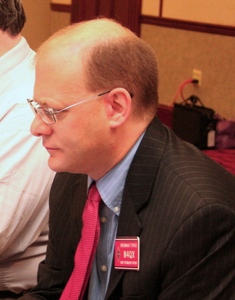
.jpg) "We believe that these steps will enhance Amateur Radio operators' privacy without undermining the public interest in knowing who is authorized to operate on amateur spectrum," the FCC said in the NPRM.
"We believe that these steps will enhance Amateur Radio operators' privacy without undermining the public interest in knowing who is authorized to operate on amateur spectrum," the FCC said in the NPRM. The FCC acknowledged that for a licensee whose residential address may already appear in ULS, this approach "offers only a partial solution," the NPRM said, "because replacing the address on a current license does not remove the old address information from archived licenses and processed applications, and it remains publicly viewable even if the license expires or is canceled or otherwise terminated."
The FCC acknowledged that for a licensee whose residential address may already appear in ULS, this approach "offers only a partial solution," the NPRM said, "because replacing the address on a current license does not remove the old address information from archived licenses and processed applications, and it remains publicly viewable even if the license expires or is canceled or otherwise terminated."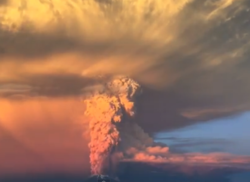
 "John is now on Falalop Island, which is part of Ulithi Atoll, in Yap state," Schneider reported. "John said the Ham Aid kit was next to him in the shack, so it made the trip all the way. He plans to deploy it at the dispensary." Bush serves as technology coordinator for the Federai Elementary School in Ulithi.
"John is now on Falalop Island, which is part of Ulithi Atoll, in Yap state," Schneider reported. "John said the Ham Aid kit was next to him in the shack, so it made the trip all the way. He plans to deploy it at the dispensary." Bush serves as technology coordinator for the Federai Elementary School in Ulithi.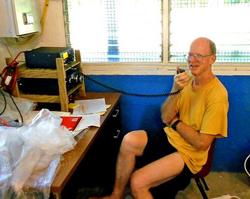
 "The Medevac just arrived half an hour ago!" DXpedition leader Leo Almazan, WA6LOS, told ARRL early on April 23. "Chito is on his way to the hospital!"
"The Medevac just arrived half an hour ago!" DXpedition leader Leo Almazan, WA6LOS, told ARRL early on April 23. "Chito is on his way to the hospital!"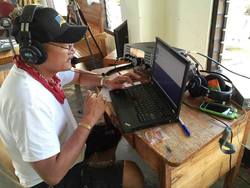
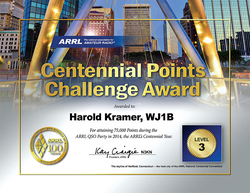 The ARRL Centennial QSO Party and W1AW/portable activities in 2014 represented the biggest on-the-air operation in the history of Amateur Radio, with more than 3.5 million Centennial event contacts recorded in LoTW. W100AW operation accounted for some 70,000 contacts.
The ARRL Centennial QSO Party and W1AW/portable activities in 2014 represented the biggest on-the-air operation in the history of Amateur Radio, with more than 3.5 million Centennial event contacts recorded in LoTW. W100AW operation accounted for some 70,000 contacts.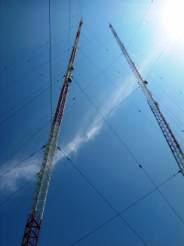 "Amateurs with ordinary facilities can use the band; exotic antennas are not required," the report said, adding "QSOs from 500 to 1000 miles are routinely achieved, and longer distances are possible." According to the report, WD2XSH operations continued throughout the winter, although transatlantic reception reports "seem[ed] to be down slightly from the previous winter."
"Amateurs with ordinary facilities can use the band; exotic antennas are not required," the report said, adding "QSOs from 500 to 1000 miles are routinely achieved, and longer distances are possible." According to the report, WD2XSH operations continued throughout the winter, although transatlantic reception reports "seem[ed] to be down slightly from the previous winter."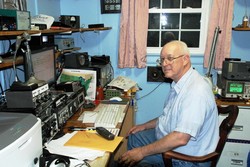
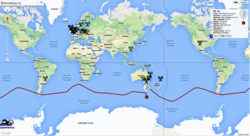
.jpg) For the third year, the ARRL exhibit will be in "student row" to introduce Amateur Radio to conference attendees. The potential audience includes students of all interests, as well as educators interested in applying the hands-on nature of ham radio to help students gain practical experience. This year, ARRL will focus on the three themes: Gaining experience, career development, and the wealth of spectrum that ham radio offers to anyone interested in RF and RF technologies.
For the third year, the ARRL exhibit will be in "student row" to introduce Amateur Radio to conference attendees. The potential audience includes students of all interests, as well as educators interested in applying the hands-on nature of ham radio to help students gain practical experience. This year, ARRL will focus on the three themes: Gaining experience, career development, and the wealth of spectrum that ham radio offers to anyone interested in RF and RF technologies.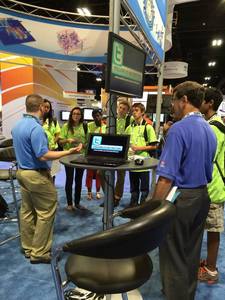
 "The CQ WW Contest Committee takes its job as referee for the contest very seriously," the Committee
"The CQ WW Contest Committee takes its job as referee for the contest very seriously," the Committee 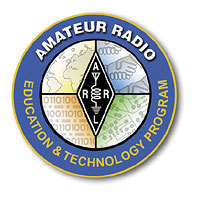 ARRL is offering three sessions of its "Introductory Teachers Institute on Wireless Technology" (TI-1) during the summer of 2015. Topics covered in the TI-1 course include basic electronics, radio science, microcontroller programming, and basic robotics. ARRL will also offer an advanced Teachers Institute (TI-2), "Remote Sensing and Data Gathering," open to applicants who have completed TI-1.
ARRL is offering three sessions of its "Introductory Teachers Institute on Wireless Technology" (TI-1) during the summer of 2015. Topics covered in the TI-1 course include basic electronics, radio science, microcontroller programming, and basic robotics. ARRL will also offer an advanced Teachers Institute (TI-2), "Remote Sensing and Data Gathering," open to applicants who have completed TI-1. 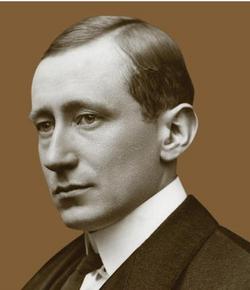 period 0000 to 2400 UTC (ie, starting the evening of Friday, April 24, in US time zones). The occasion offers an opportunity to contact historic Marconi-related radio sites around the world on HF.
period 0000 to 2400 UTC (ie, starting the evening of Friday, April 24, in US time zones). The occasion offers an opportunity to contact historic Marconi-related radio sites around the world on HF.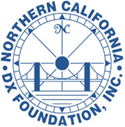 November 2015. In the wake of the recent Navassa operation, Heard Island has moved up to number 5 on the ClubLog
November 2015. In the wake of the recent Navassa operation, Heard Island has moved up to number 5 on the ClubLog  Predicted solar flux for the near term is 150 and 145 on April 23-24, 140 on April 25-30, 135 on May 1, 130 on May 2-5, 135 and 140 on May 6-7, 145 on May 8-9, 140 on May 10, 135 on May 11-16, and 150 on May 17-18.
Predicted solar flux for the near term is 150 and 145 on April 23-24, 140 on April 25-30, 135 on May 1, 130 on May 2-5, 135 and 140 on May 6-7, 145 on May 8-9, 140 on May 10, 135 on May 11-16, and 150 on May 17-18.







